Unlike in Egypt and Tunisia, two countries that experienced relatively quick turnaround time from when the demonstrations began to when their desires were met, Syria is still an ongoing conflict. Actually, Syria is spiraling increasingly worse as each day passes. The peaceful protests that started the conflict, eventually progressed into a civil war that has decimated the landscape and led to a massive humanitarian and refugee crisis.
Bashar al Assad is the current president of Syria. He came into power after his father, Hafez al Assad died in July 2000. Originally, Bashar al Assad went to medical school, but was forced to turn back to Syria and begin his life in the political sphere when his older brother was killed in an automobile accident. In his first speech as president, he seemed optimistic, and promised to make sweeping strides toward reforming the political system and the economy. However, it was not long before it became clear that he was not going to be ruling his people with a kind heart.
Human rights reforms within the country were promised, but not fulfilled. Human Rights Watch noted that in 2009, Syria was one of the top countries with the worst human rights violations in the world. In addition, the government cracked down on political dissidents, often violently. Furthermore, elections were not free and fair. Bashar al Assad was often the only candidate on the ballot. These issues, along with the demand to an end to the state of emergency, brewed the beginnings of another Arab Spring uprising.
On March 15, 2011, Syrians took to the streets in the first day of protests against the Assad regime. These protests continued into the fall of 2011, and in the first six months of the conflict, over two thousand protestors had been killed in the conflict. In addition, a massive refugee crisis engulfed the region and spread throughout the world. Syrians fled to Turkey, Lebanon, and other nearby countries, even becoming so desperate to escape the conflict that they sailed on rafts across the Mediterranean to Europe. The international community began to raise eyebrows at the Assad regime, and questioned his tactics to control the protestors, who he referred to as “terrorists.”
“I’m president. I don’t own the country. No government in the world kills its people, unless it is led by a crazy person.” -Bashar al Assad
The conflict continued to spiral. Arab observers from the Arab League were granted access to the country to assess the damage from the conflict. They reported in January 2012 that over five thousand civilians had been killed by the military, and an additional thousand had been killed by rebel forces. Over a year later, in June of 2012, the United Nations deemed it was no longer a small conflict, consisting of mostly peaceful protests, marked by skirmishes between protesters and the militia. It had now progressed into a complete civil war. In August 2013, Assad allegedly used chemical weapons on his own citizens. At this point, President Putin of Russia came to Assad’s defense, and assisted him in dismantling his weapons stockpile. However, before January of 2013, the humanitarian crisis had reached unfathomable levels of destruction. Over seventy-thousand people had been killed in the conflict.
As the years passed, Assad maintained control of his country through sham elections and more strikes against his own people. Before the Trump administration, the United States had only taken a stance against the Assad regime and supplied weapons and training to the rebels who were only fighting ISIS, and not the Assad regime. However, in April 2017, American President Donald Trump authorized missile strikes on a Syrian airbase after evidence surfaced of yet another chemical attack organized by Assad. Still, Assad could not be stopped. In April 2018, yet again video surfaced of Syrians post-chemical attack. In a coalition force with England and France, further airstrikes were launched against Syria.
As of today, the conflict is still ongoing. International aid groups estimate that over 465,000 people have fallen victim to the conflict since the protests first began back in March 2011. The United Nations High Commissioner for Refugees estimates that over 5.7 million Syrians have fled their country in search of asylum in other countries, and an additional six million are internally displaced as a result of the rise of ISIS and battles between Kurdish forces, Assad-loyal forces, and rebels. Syria will be forever altered by their failed attempt at another Arab Spring uprising.
Art of Resistance
One of the most famous artists in the Syrian conflict is Abu Malik al-Shami. Although since 2016 he has laid low and not completed any work, during 2014-2016 he was incredibly active in locations that were being absolutely ravished by the civil war. He is now in his early twenties, and understood that his purpose in the demonstrations was to use his gift of artistic talent to help spread the ideology of the protesters. Eventually, he decided to join the Free Syrian Army, or the group of rebels who decided to take up arms against the Assad regime.
When asked when the best times were to complete his artwork, al-Shami said to BBC:
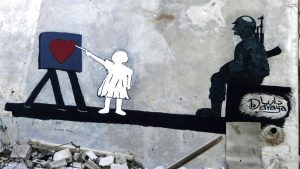
This is one of his first works. It depicts a girl pointing to a heart as if she is teaching. Sitting and observing the lesson is a soldier.
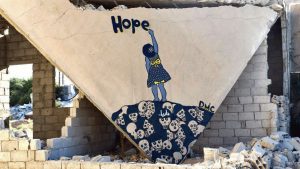
His first piece that gained international acknowledgement was this image of a young girl standing on a pile of skulls. Above her, is the word “hope.”
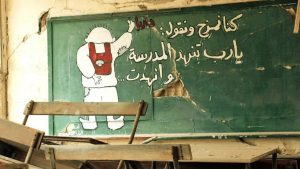
This is another one of his pieces, completed with just paint. This is located in a school that had been hit by bombs and gunfire. The student is accompanied with the text, “We used to joke and say, God please destroy the school…and he did.”
Aside from al-Shami, there is not really any other prominent street artists. Most murals in war torn areas do not stay in tact very long, as the likelihood they will be struck by bomb or gunfire is high. In addition, it’s incredibly dangerous for artists to be out and about painting their murals. This is not necessarily because of fear of being arrested, like in Egypt or Tunisia. Instead this is more a fear of being struck by a sniper, a missle, or a bomb. Artists also are under extreme pressure to find supplies as well. The country is absolutely decimated–and it is clear why there is not an abundance of paint to go around. However, some smaller pieces by unknown artists have been documented by ameteaur photographers in the region. Here are some below.
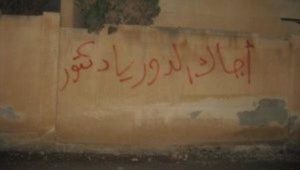
This piece is done strictly in spray paint. This reads, “Your turn has come, doctor.” This is in reference to Bashar al Assad. It was previously mentioned that al Assad was originally in medical school studying to be a doctor, but then was forced into politics when his brother died. This was not done by a famous graffiti artist, but instead by a fifteen year old boy, Bashir Abazid, in his hometown of Daraa. He was caught by the police, and was tortured for over a month by the military for his act of public defiance. This event actually sparked some Syrians to begin protesting back in 2011. The unfair treatment of the boys who had been arrested was a textbook example of how the regime would silence anyone who dared speak out against it. This crude scrawl of a political message inspired others to act just like Abazid did. They also wrote little political messages against Assad around their hometowns.
Aside from street art, little else has been seen by the Western world and the international community as a whole. This is mainly because of the lack of witnesses on the ground, paired with the danger of the situation. Now, the conflict is more life and death than anything else. However, some graphic designers who were part of the mass exodus of refugees from the civil war have gained international notoriety for their take on the political developments.
This is a portrait done by Abdalla al Omari. This was just one in a series of many portraits of world leaders shown in tattered clothing and in distress. This particular painting is of Bashar al Assad . His clothes are dripping, and he is holding a paper sailboat hat over his head. He is depicted to look as if he is emerging from the water–much like how many of the Syrian refugees were forced to when they went fled the civil war. The hat to me symbolizes the youth of some of the refugees. I think of the many children who have perished along their journey to refugee camps and to asylum in other countries. I think Omari was attempting to hint at that in this work. This painting was on display in Dubai until 2017.
Pictured below is another one of Omari’s portraits, titled, “Syrian Child.”
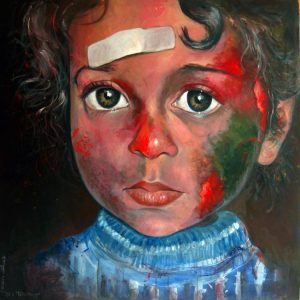
Beginning in 2012, his art began to take more of a turn toward focusing on the Syrian conflict. This portrait shows a girl who looks aged beyond her years from the conflict.

This piece is titled, “Kids are Watching.” On the chalkboard in the back, you can see a child’s drawing of a plane dropping bombs on a city.
